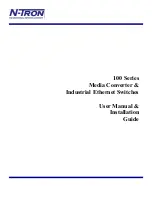
~
16
~
Save[Y].
Save present operation to the preset command [Y].
[Y] ranges from 0 to 9.
Recall[Y].
Recall the preset command [Y]
Clear[Y].
Clear the preset command [Y]
Note:
1. [x1], [x2], [x3] and [x4] are the symbols of input or output channels ranged
according to the model of the matrix switcher. If the symbols exceed the effective
range, it would be taken as a wrong command.
2. In above commands, “[”and “]” are symbols for easy reading and do not need to be
typed in actual operation.
3. Please remember to end the commands with the ending symbols “.” and “;”.
Detail Examples:
1. Transfer signals from an input channel to all output channels: [x1]All.
Example: To transfer signals from the input channel No.3 to all output channels. Run
Command: “3All.”
2. Transfer all input signals to the corresponding output channels respectively:
All#.
Example: The status of it will be: 1->1, 2->2, 3->3, 4->4……16->16.
3. Switch off all output channels: All$.
Example: After running this command, there will be no signals on all the output
channels.
4. Check
firmware
version:
/^Version;
Unit will reply back with the current firmware version.
5. Switch off feedback commands from serial port: /:MessageOff;
Switch off feedback information from the serial port. The unit will reply with “switch
OK” as the feedback after each operation.
6. Switch on feedback command from serial port: /:MessageOn;
Switch on feedback information from the serial port. The unit will show status
information when it switches. Example: when switch 1->2 for Audio, it will reply back
with “A0102”.
7. Transfer signals from an input channel to the corresponding output channel:
[x]#.
Example: To transfer signals from the input channel No.5 to the output channel No.5.
Run Command: “5#.”
8. Switch off output channel: [x]$.
Example: To switch off the output channel No.5. Run Command: “5$.”
9. Switch video signals command: [x1]V[x2].
Example: To transfer the video signals from the input channel No.3 to the output
channel No.5.



































